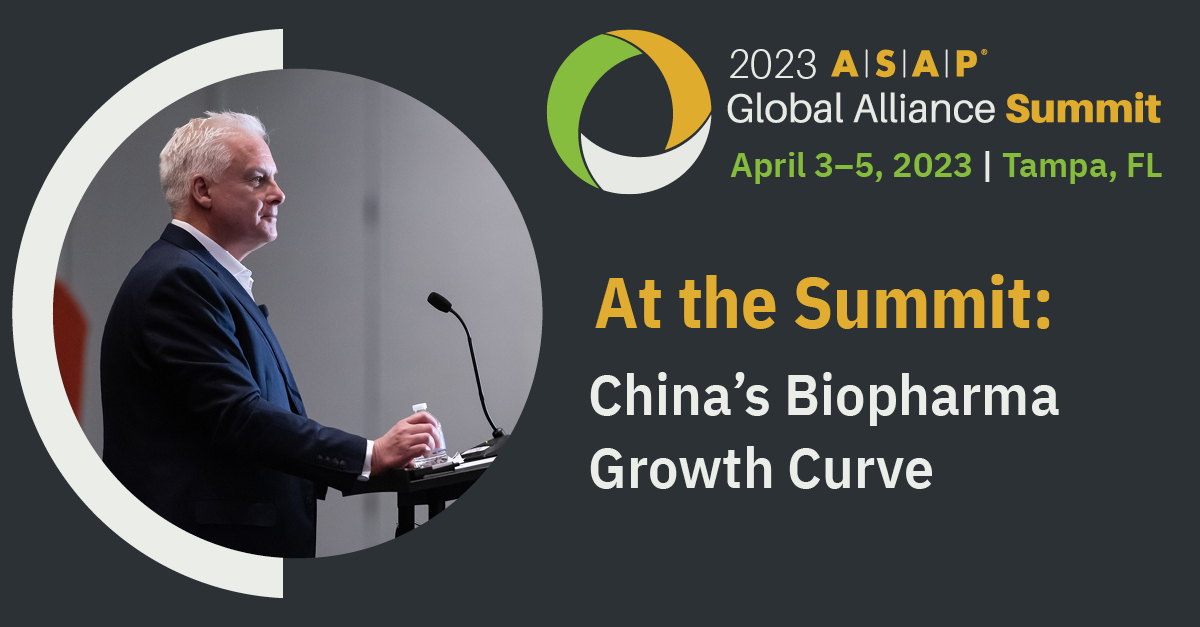China’s Biopharma Growth Curve
It’s no secret that some of the greatest economic growth engines have been roaring in East Asia, even through the vicissitudes of the pandemic. In biopharma in particular, South Korea and China have led the way. And while Covid restrictions have hindered in-person meetings with partners until recently, things are booming once again across the Pacific.
But for organizations based in Europe or the United States, partnering with a Chinese company presents some significant and very real challenges. That was among the acknowledgments made by Kevin Oliver, senior vice president, global head of BD&L, and COO for US and Europe at the Chinese-owned Simcere Pharmaceutical Group, in his keynote address on day two of the ASAP Global Alliance Summit in Tampa today.
The speech was titled “Changing Alliance Paradigms on the Global Stage,” but it was more of a cultural and economic history of both Simcere as a company—or constellation of companies—and the progress of Chinese biopharma as an industry that is rapidly growing and globalizing, as well as the emerging role of alliance management in that growth surge.
Hockey Sticks and Geopolitical Kicks
Oliver termed alliance management “a learning experience day by day,” and noted that “why this matters now” is because biopharma as an industry “is booming in China, especially since 2021.” He observed that the “status quo” in the industry has featured the dominance of European and US companies, with some Japanese firms, notably Takeda, also taking the lead.
Takeda, in fact, forms something of a model or template for the rise of Simcere, something Oliver was forthright about. “We want to be the Chinese Takeda,” he said. “We look to Takeda as a great example of how we might globalize,” both in its partnering efforts and its acquisitions. Whereas Takeda is some three centuries old, however, Simcere was founded less than three decades ago—so its seemingly meteoric rise actually represents a massive effort to play catch-up.
Yet Simcere’s growth has been impressive, with a recent 20 percent jump in drug submissions. China is also fertile ground for biopharma, with 29 percent of the world aged population and significant numbers of people with Parkinson’s disease, which is considered more rare in the West. Both China and South Korea have significantly increased the number of their biopharma alliances, according to Oliver, with upward trends in both in-licensing and out-licensing. These upward-trending hockey-stick curves maintained their shape until sometime last year, when “geopolitics really kicked in,” he said.
Simcere sees itself as an innovative, patient-centered pharma company, with 29 percent of its revenue plowed back into R&D. “It’s very R&D driven,” Oliver acknowledged.
Alliance Management Comes to the Table
He noted that in Chinese companies generally, alliance management is still “relatively immature…it’s project management oriented.” By that he meant that traditionally alliance functions where they existed were often headed up by project managers and handled in a project management style. Alliance management is only now starting to come to the table and show its value to skeptical senior leaders.
Oliver also admitted that to Westerners, working for or partnering with a Chinese company can prove “complicated, hard to explain, and maybe somewhat irrational—but there’s a cultural logic to it.” Even Simcere’s division into multiple corporate entities—not uncommon in China—“can be confusing to a partner.”
Also confusing are the cultural differences between China and the West, and what can seem like barriers to effective partnering. Among them:
- Cross-border alliances are still relatively new
- The language barrier is still real, especially among senior leaders (although younger Chinese employees typically do speak some English)
- Cultural and language differences make it imperative to be proactive in avoiding disputes
- There’s a need for business development to be integrated with alliance management
- China is 12 hours ahead of US Eastern Time, for example, leading to an almost 24-hour workday for some and a need to double up on presentations for different audiences
- A bias toward in-person meetings made for difficulties during Covid, but is changing now as Covid restrictions have eased; remote work is largely seen as “unacceptable”
School Days and Culture Shocks
To make sense of all this, Oliver recommended a book called Culture Hacks: Deciphering Differences in American, Chinese, and Japanese Thinking by Richard Conrad (2019). Cultural differences, he said, “amplify an already difficult job.” He characterized American and Western thinking as typically “linear,” Japanese as “intuitive,” and the Chinese approach as “lateral.” There is great focus on preserving—or not losing—“face,” on maintaining respect, and on following or at least not appearing to break what can be fairly rigid rules.
“These are enormous cultural differences,” Oliver admitted. “And they aren’t going to change. Every day’s a school day at Simcere.”
So for US and EU companies seeking to partner with Chinese firms, there’s great opportunity—but it also comes with caveats. Meetings and negotiations may have hidden dimensions or agendas that are not sinister, but simply unknown to all but the most senior Chinese executives. Those agendas may be driven by offstage actors or advisers, or by the ambitions of senior leaders who are constantly raising the bar and driving their people to do better than last year.
Whether because of or in spite of this phenomenon, Oliver sees a potential future of “profound global success” for Simcere and other Chinese biopharma companies, if all goes well.
“We’re at this strange but profound transition period,” he said. “Which way will it go?”
Which way should you go for more news from the Summit in Tampa? You’re already there. Check back with the ASAP Blog for more updates and continuing coverage of all the latest partnering highlights that have been shining brightly at the Summit!

